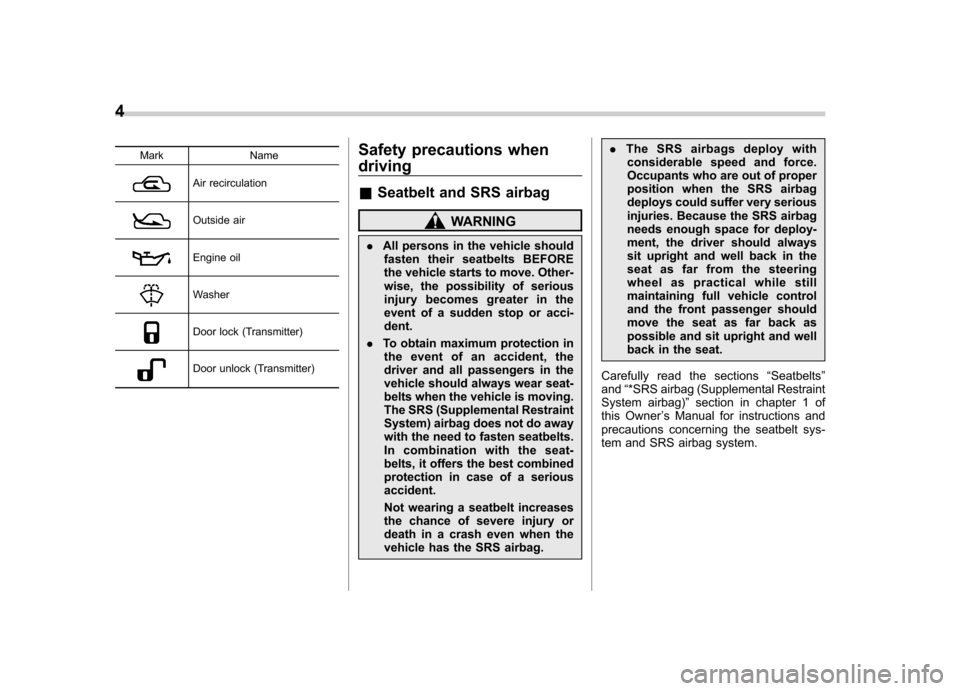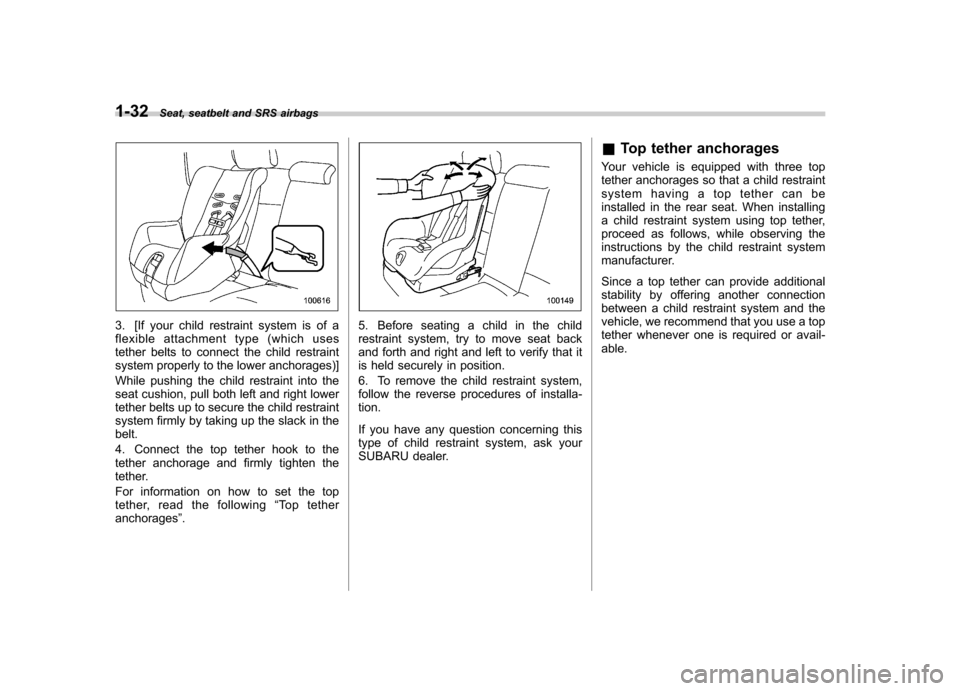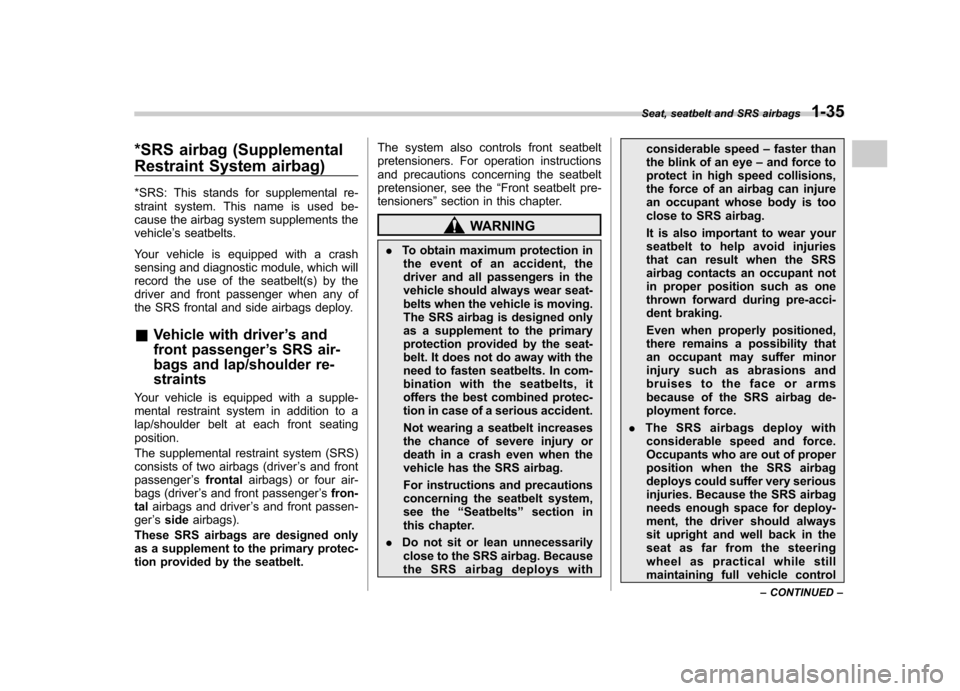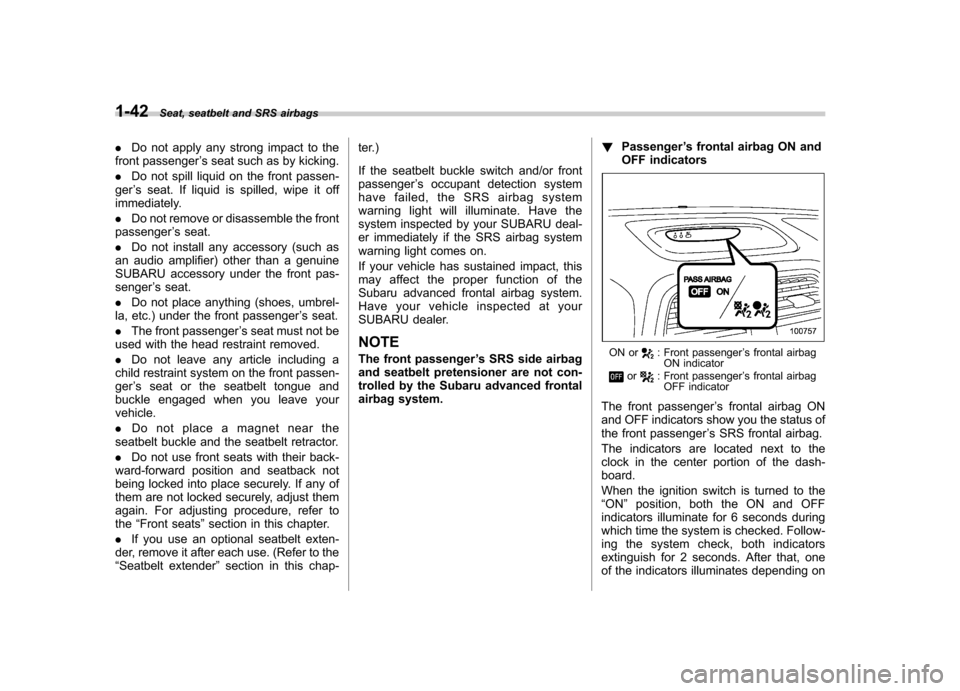2007 SUBARU IMPREZA airbag off
[x] Cancel search: airbag offPage 6 of 364

4
Mark Name
Air recirculation
Outside air
Engine oil
Washer
Door lock (Transmitter)
Door unlock (Transmitter)Safety precautions when driving &
Seatbelt and SRS airbag
WARNING
. All persons in the vehicle should
fasten their seatbelts BEFORE
the vehicle starts to move. Other-
wise, the possibility of serious
injury becomes greater in the
event of a sudden stop or acci-dent.
. To obtain maximum protection in
the event of an accident, the
driver and all passengers in the
vehicle should always wear seat-
belts when the vehicle is moving.
The SRS (Supplemental Restraint
System) airbag does not do away
with the need to fasten seatbelts.
In combination with the seat-
belts, it offers the best combined
protection in case of a seriousaccident.
Not wearing a seatbelt increases
the chance of severe injury or
death in a crash even when the
vehicle has the SRS airbag. .
The SRS airbags deploy with
considerable speed and force.
Occupants who are out of proper
position when the SRS airbag
deploys could suffer very serious
injuries. Because the SRS airbag
needs enough space for deploy-
ment, the driver should always
sit upright and well back in the
seat as far from the steering
wheel as practical while still
maintaining full vehicle control
and the front passenger should
move the seat as far back as
possible and sit upright and well
back in the seat.
Carefully read the sections “Seatbelts ”
and “*SRS airbag (Supplemental Restraint
System airbag) ”section in chapter 1 of
this Owner ’s Manual for instructions and
precautions concerning the seatbelt sys-
tem and SRS airbag system.
Page 24 of 364

22
&WARNING AND INDICATOR LIGHT
Mark Name Page
Seatbelt warning light 3-14
SRS airbag system
warning light 3-14
orPassenger airbag ON
indicator light3-15
orPassenger airbag OFF
indicator light3-15
CHECK ENGINE
warning light/Malfunction
indicator lamp3-16
Charge warning light 3-16
Oil pressure warning light
3-16
AT OIL temperature
warning light (if equipped)3-17Mark Name Page
orABS warning light 3-17
orBrake system warning light
3-18
Door open warning light 3-19
All-Wheel Drive warning
light (if equipped)3-19
Turn signal indicator lights3-20
High beam indicator light 3-20
Security indicator light
2-4,
2-13
Intercooler water spray
warning light (if
equipped) 3-19
Lights indicator light (if
equipped)
3-21
Cruise control indicator light3-20Mark Name Page
Cruise control set indi-
cator light
3-20
REV indicator light (if
equipped)3-21
Rear differential oil tem-
perature warning light (if
equipped)3-17
Driver
’s control center
differential auto indicator
light (if equipped) 3-20
Driver
’s control center
differential indicator light
(if equipped) 3-21
Driver
’s control center
differential indicator and
warning lights (if
equipped) 3-21
Page 30 of 364

tion on the seat.
. If your vehicle is involved in a
rear-end collision, have an
authorized SUBARU dealer in-
spect the active head restraints.
. The active head restraints may
not operate in the event the
vehicle experiences only a slight
impact in the rear.
. The active head restraints may be
damaged if they are pushed hard
from behind or subjected to
shock. As a result, they may not
function if the vehicle suffers a
rear impact. Seat heater (if equipped)
Driver
’s side
1) HI–Rapid heating
2) LO–Normal heating
Front passenger ’s side
1) HI–Rapid heating
2) LO–Normal heating
The seat heater operates when the igni-
tion switch is either in the “Acc ”or “ON ”
position.
To turn on the seat heater, push the “LO ”
or “HI ”position on the switch, as desired,
depending on the temperature. Selecting the “HI ”position will cause the seat to heat
up quicker.
The indicator located on the switch comes
on when the seat heater is in operation.
When the vehicle ’s interior is warmed
enough or before you leave the vehicle,
be sure to turn the switch off. Seat, seatbelt and SRS airbags
1-5
– CONTINUED –
Page 46 of 364

tion switch is turned to the“ON ”position.
The following components are monitored
by the indicator: . Front sub sensor (Right-hand side)
. Front sub sensor (Left-hand side)
. Airbag control module (including im-
pact sensors). Frontal airbag module (Driver ’s side)
. Frontal airbag module (Front passen-
ger ’s side)
. Side airbag sensor (Center pillar right-
hand side). Side airbag sensor (Center pillar left-
hand side). Side airbag module (Driver ’s side)
. Side airbag module (Front passenger ’s
side). Seatbelt pretensioner (Driver ’s side)
. Seatbelt pretensioner (Front passen-
ger ’s side)
. Seatbelt buckle switch (Driver ’s side)
. Seatbelt buckle switch (Front passen-
ger ’s side)
. Driver ’s seat position sensor
. Front passenger ’s seatbelt tension
sensor. Front passenger ’s occupant detection
system weight sensor. Front passenger ’s occupant detection
control module .
Front passenger ’s frontal airbag ON
and OFF indicator. All related wiring
WARNING
If the warning light exhibits any of
the following conditions, there may
be a malfunction in the seatbelt
pretensioners and/or SRS airbag
system. Immediately take your vehi-
cle to your nearest SUBARU dealer
to have the system checked. Unless
checked and properly repaired, the
seatbelt pretensioners and/or SRS
airbag will not operate properly in
the event of a collision, which may
increase the risk of injury. . Flashing or flickering of the warn-
ing light
. No illumination of the warning
light when the ignition switch is
first turned to the “ON ”position
. Continuous illumination of the
warning light
. Illumination of the warning light
while driving &
System servicing
WARNING
. When discarding a seatbelt re-
tractor assembly or scrapping
the entire vehicle damaged by a
collision, consult your SUBARU
dealer.
. Tampering with or disconnecting
the system ’s wiring could result
in accidental activation of the
seatbelt pretensioner and/or
SRS airbag or could make the
system inoperative, which may
result in serious injury. The wir-
ing harnesses of the seatbelt
pretensioner and SRS airbag
systems are covered with yellow
insulation and the connectors of
the system are yellow for easy
identification. Do not use electri-
cal test equipment on any circuit
related to the seatbelt preten-
sioner and SRS airbag systems.
For required servicing of the
seatbelt pretensioner, see your
nearest SUBARU dealer.
Seat, seatbelt and SRS airbags
1-21
– CONTINUED –
Page 57 of 364

1-32Seat, seatbelt and SRS airbags
3. [If your child restraint system is of a
flexible attachment type (which uses
tether belts to connect the child restraint
system properly to the lower anchorages)]
While pushing the child restraint into the
seat cushion, pull both left and right lower
tether belts up to secure the child restraint
system firmly by taking up the slack in thebelt.
4. Connect the top tether hook to the
tether anchorage and firmly tighten the
tether.
For information on how to set the top
tether, read the following “Top tether
anchorages ”.5. Before seating a child in the child
restraint system, try to move seat back
and forth and right and left to verify that it
is held securely in position.
6. To remove the child restraint system,
follow the reverse procedures of installa-tion.
If you have any question concerning this
type of child restraint system, ask your
SUBARU dealer. &
Top tether anchorages
Your vehicle is equipped with three top
tether anchorages so that a child restraint
system having a top tether can be
installed in the rear seat. When installing
a child restraint system using top tether,
proceed as follows, while observing the
instructions by the child restraint system
manufacturer.
Since a top tether can provide additional
stability by offering another connection
between a child restraint system and the
vehicle, we recommend that you use a top
tether whenever one is required or avail-able.
Page 60 of 364

*SRS airbag (Supplemental
Restraint System airbag)
*SRS: This stands for supplemental re-
straint system. This name is used be-
cause the airbag system supplements thevehicle’s seatbelts.
Your vehicle is equipped with a crash
sensing and diagnostic module, which will
record the use of the seatbelt(s) by the
driver and front passenger when any of
the SRS frontal and side airbags deploy. & Vehicle with driver ’s and
front passenger ’s SRS air-
bags and lap/shoulder re- straints
Your vehicle is equipped with a supple-
mental restraint system in addition to a
lap/shoulder belt at each front seatingposition.
The supplemental restraint system (SRS)
consists of two airbags (driver ’s and front
passenger ’s frontal airbags) or four air-
bags (driver ’s and front passenger ’s fron-
tal airbags and driver ’s and front passen-
ger ’s side airbags).
These SRS airbags are designed only
as a supplement to the primary protec-
tion provided by the seatbelt. The system also controls front seatbelt
pretensioners. For operation instructions
and precautions concerning the seatbelt
pretensioner, see the
“Front seatbelt pre-
tensioners ”section in this chapter.
WARNING
. To obtain maximum protection in
the event of an accident, the
driver and all passengers in the
vehicle should always wear seat-
belts when the vehicle is moving.
The SRS airbag is designed only
as a supplement to the primary
protection provided by the seat-
belt. It does not do away with the
need to fasten seatbelts. In com-
bination with the seatbelts, it
offers the best combined protec-
tion in case of a serious accident.
Not wearing a seatbelt increases
the chance of severe injury or
death in a crash even when the
vehicle has the SRS airbag.
For instructions and precautions
concerning the seatbelt system,
see the “Seatbelts ”section in
this chapter.
. Do not sit or lean unnecessarily
close to the SRS airbag. Because
the SRS airbag deploys with considerable speed
–faster than
the blink of an eye –and force to
protect in high speed collisions,
the force of an airbag can injure
an occupant whose body is too
close to SRS airbag.
It is also important to wear your
seatbelt to help avoid injuries
that can result when the SRS
airbag contacts an occupant not
in proper position such as one
thrown forward during pre-acci-
dent braking.
Even when properly positioned,
there remains a possibility that
an occupant may suffer minor
injury such as abrasions and
bruises to the face or arms
because of the SRS airbag de-
ployment force.
. The SRS airbags deploy with
considerable speed and force.
Occupants who are out of proper
position when the SRS airbag
deploys could suffer very serious
injuries. Because the SRS airbag
needs enough space for deploy-
ment, the driver should always
sit upright and well back in the
seat as far from the steering
wheel as practical while still
maintaining full vehicle control
Seat, seatbelt and SRS airbags
1-35
– CONTINUED –
Page 63 of 364

1-38Seat, seatbelt and SRS airbags
! Components
1) Airbag control module (including impact
sensors)
2) Frontal airbag module (Driver ’s side)
3) Frontal airbag module (Front passen- ger’s side)
4) Front sub sensor (Left-hand side)
5) Front sub sensor (Right-hand side)
6) Side airbag module (Driver ’s side)
7) Side airbag module (Front passenger ’s
side)
8) Side airbag sensor (Center pillar left- hand side)
9) Side airbag sensor (Center pillar right- hand side)
10) Airbag wiring (Yellow)
11) Seatbelt pretensioner (Driver ’s side)
12) Seatbelt pretensioner (Front passenger ’s
side)
13) Seatbelt buckle switch (Front passen- ger’s side)
14) Seatbelt buckle switch (Driver ’s side)
15) Driver ’s seat position sensor
16) Front passenger ’s seatbelt tension sen-
sor
17) Front passenger ’s occupant detection
system weight sensor
18) Front passenger ’s occupant detection
control module
19) Front passenger ’s frontal airbag ON and
OFF indicator
20) SRS airbag system warning light
Page 67 of 364

1-42Seat, seatbelt and SRS airbags
. Do not apply any strong impact to the
front passenger ’s seat such as by kicking.
. Do not spill liquid on the front passen-
ger ’s seat. If liquid is spilled, wipe it off
immediately. . Do not remove or disassemble the front
passenger ’s seat.
. Do not install any accessory (such as
an audio amplifier) other than a genuine
SUBARU accessory under the front pas-senger ’s seat.
. Do not place anything (shoes, umbrel-
la, etc.) under the front passenger ’s seat.
. The front passenger ’s seat must not be
used with the head restraint removed. . Do not leave any article including a
child restraint system on the front passen- ger ’s seat or the seatbelt tongue and
buckle engaged when you leave yourvehicle. . Do not place a magnet near the
seatbelt buckle and the seatbelt retractor.. Do not use front seats with their back-
ward-forward position and seatback not
being locked into place securely. If any of
them are not locked securely, adjust them
again. For adjusting procedure, refer tothe “Front seats ”section in this chapter.
. If you use an optional seatbelt exten-
der, remove it after each use. (Refer to the“ Seatbelt extender ”section in this chap- ter.)
If the seatbelt buckle switch and/or front passenger
’s occupant detection system
have failed, the SRS airbag system
warning light will illuminate. Have the
system inspected by your SUBARU deal-
er immediately if the SRS airbag system
warning light comes on.
If your vehicle has sustained impact, this
may affect the proper function of the
Subaru advanced frontal airbag system.
Have your vehicle inspected at your
SUBARU dealer.
NOTE
The front passenger ’s SRS side airbag
and seatbelt pretensioner are not con-
trolled by the Subaru advanced frontal
airbag system. !
Passenger ’s frontal airbag ON and
OFF indicators
ON or: Front passenger ’s frontal airbag
ON indicator
or: Front passenger ’s frontal airbag
OFF indicator
The front passenger ’s frontal airbag ON
and OFF indicators show you the status of
the front passenger ’s SRS frontal airbag.
The indicators are located next to the
clock in the center portion of the dash-board.
When the ignition switch is turned to the “ ON ”position, both the ON and OFF
indicators illuminate for 6 seconds during
which time the system is checked. Follow-
ing the system check, both indicators
extinguish for 2 seconds. After that, one
of the indicators illuminates depending on